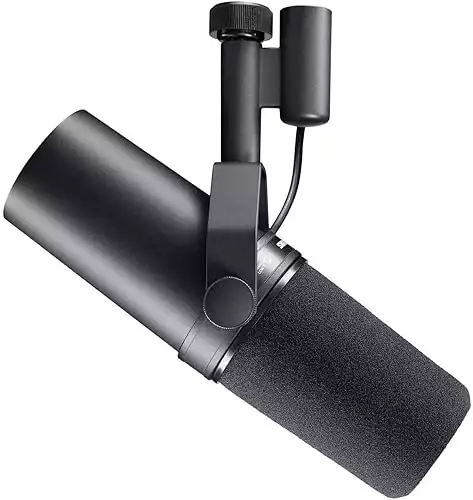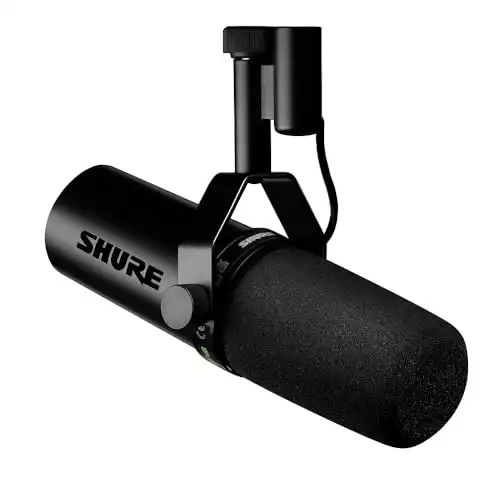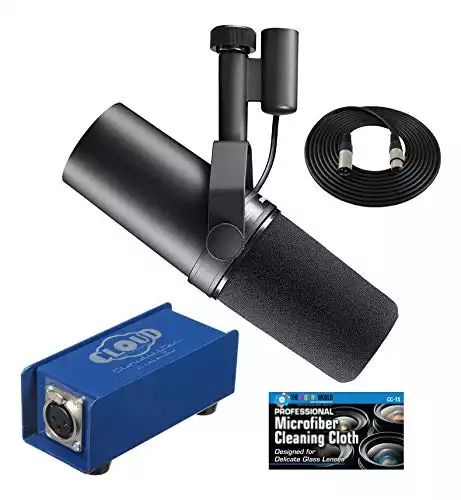Note: This article contains affiliate links. We may earn a commission if you make a purchase, at no additional cost to you.
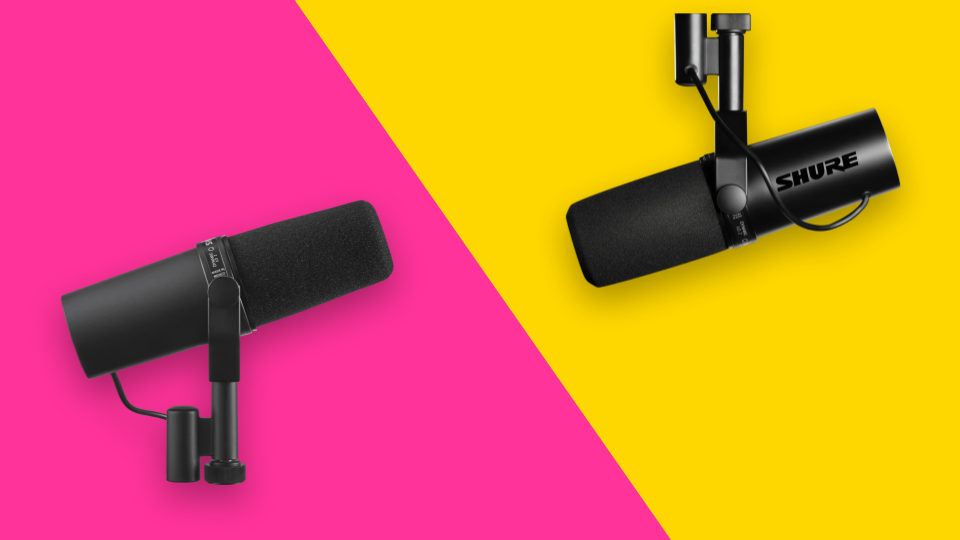
The Shure SM7B is arguably the most legendary broadcast microphone ever. And with the new SM7dB, you might have one of two questions:
- Which microphone should I buy?
- Should I upgrade my SM7B to the SM7dB?
Both microphones give you that legendary “Shure sound”, but the SM7dB has a built-in gain boost that makes it more versatile and user-friendly.
After doing some digging, I’ve found that both microphones are roughly the same in terms of performance. Which one you get ultimately comes down to your individual needs and preferences.
Quick Look: Shure SM7B vs SM7dB
|
$399.00
|
$499.00
|
|
|
|
|
- Iconic broadcast microphone that's great for any recording setup
- Smooth, dark sound is flattering for most voices
- Low-sensitivity makes it great for rejecting background noise
- Requires lots of gain — you may need an external signal booster
- Same iconic SM7B sound
- Built-in gain boost removes need for external preamps
- Great for older audio interfaces with low preamp gain
- Back switches are more user-friendly
- Higher noise floor when gain boost turned on
- Modern interfaces & mixers make the built-in booster redundant
- Shure branding on the mic may be a turn-off for some users
Who is Each Mic For?
For the most part, these are the exact same microphone. That said, each one is better suited for certain situations:
Get the SM7B if you…
- Want the classic SM7B sound with no extra bells or whistles.
- Have a modern audio interface or mixer with at least +69db preamp gain.
- Already have an external preamp or Cloudlifter to handle the gain boost.
- Don’t want to spend the extra $100 on the SM7dB.
Get the SM7dB if you…
- Want the SM7B sound regardless of price.
- Don’t want to use an external signal booster or preamp.
- Want to reduce the amount of in-line gear in your setup.
- Have an older audio interface with a lower gain range.
- Want the flexibility to switch between different setups.
Should You Upgrade from the SM7B to the SM7dB?
There’s no need to upgrade if you already have an SM7B and it’s working for you. Again, they’re practically the same in terms of sound quality and performance.
The only reason I’d upgrade is if you want to reduce the amount of gear in your signal path.
- A common setup for the SM7B includes the microphone, a signal booster, two XLR cables, and an audio interface. That’s at least five pieces of gear!
- On the other hand, the pathway for an SM7dB might just include the microphone, a single XLR cable, and the interface.
It’s less stuff to keep track of, and it reduces the potential points of failure in your signal chain.
Plus, the SM7dB is ultimately cheaper than buying the SM7B with a Cloudlifter.
|
$499.00
|
$599.99
|
|
Shure's new and improved broadcast microphone. It has the same smooth sound as the classic SM7B, but has the added benefit of a built-in preamp. Plug it directly into your audio interface without using any external signal boosters! |
Get the Shure SM7B microphone with everything you need to be heard loud and clear. The bundle includes the mic with the CL-1 Cloudlifter, an extra XLR cable, and other accessories. |
Shure's new and improved broadcast microphone. It has the same smooth sound as the classic SM7B, but has the added benefit of a built-in preamp. Plug it directly into your audio interface without using any external signal boosters!
Get the Shure SM7B microphone with everything you need to be heard loud and clear. The bundle includes the mic with the CL-1 Cloudlifter, an extra XLR cable, and other accessories.
Things That Are the Same
Simply put, the SM7dB is a revision of the classic SM7B microphone. So of course they’re going to look and sound similar.
Here’s everything that’s more or less the same:
- Overall shape and design
- Microphone capsule & sound quality
- Frequency response: 50Hz–20kHz
- Cardioid pickup pattern
- EQ options
Things That Are Different
There are some differences between these two mics, both big and small. Let’s take a look:
Built-In Signal Booster
The SM7B is a notoriously quiet microphone. Historically, the solution was to plug it into a preamp or signal booster.
The SM7dB solves this problem by including a built-in signal booster. On the back, you can switch between +18db and +28db of gain. That way, you can use the mic with any mixer or audio interface without the extra gear.
The built-in gain boost would have been a nice feature 5-6 years ago. But today’s modern interfaces offer enough gain to run the original SM7B without any problems.
If your interface has a preamp that offers roughly +70db of gain, you won’t need the SM7dB.
Looking for Audio Interface Recommendations?
If you need an audio interface with high enough gain for the SM7B, try looking into the Focusrite Scarlett 4th Gen series.
Noise Floor
One criticism against the SM7dB is the noise floor — it tends to produce a low static hum when the gain boost is turned on. But when you bypass it, you get a clean signal.
It’s not a big deal, and most people won’t ever notice it unless you point it out. But it’s there.
On its own, the original SM7B’s signal is also clean. That said, there may be a noise floor once you introduce an extra device like a Cloudlifter.
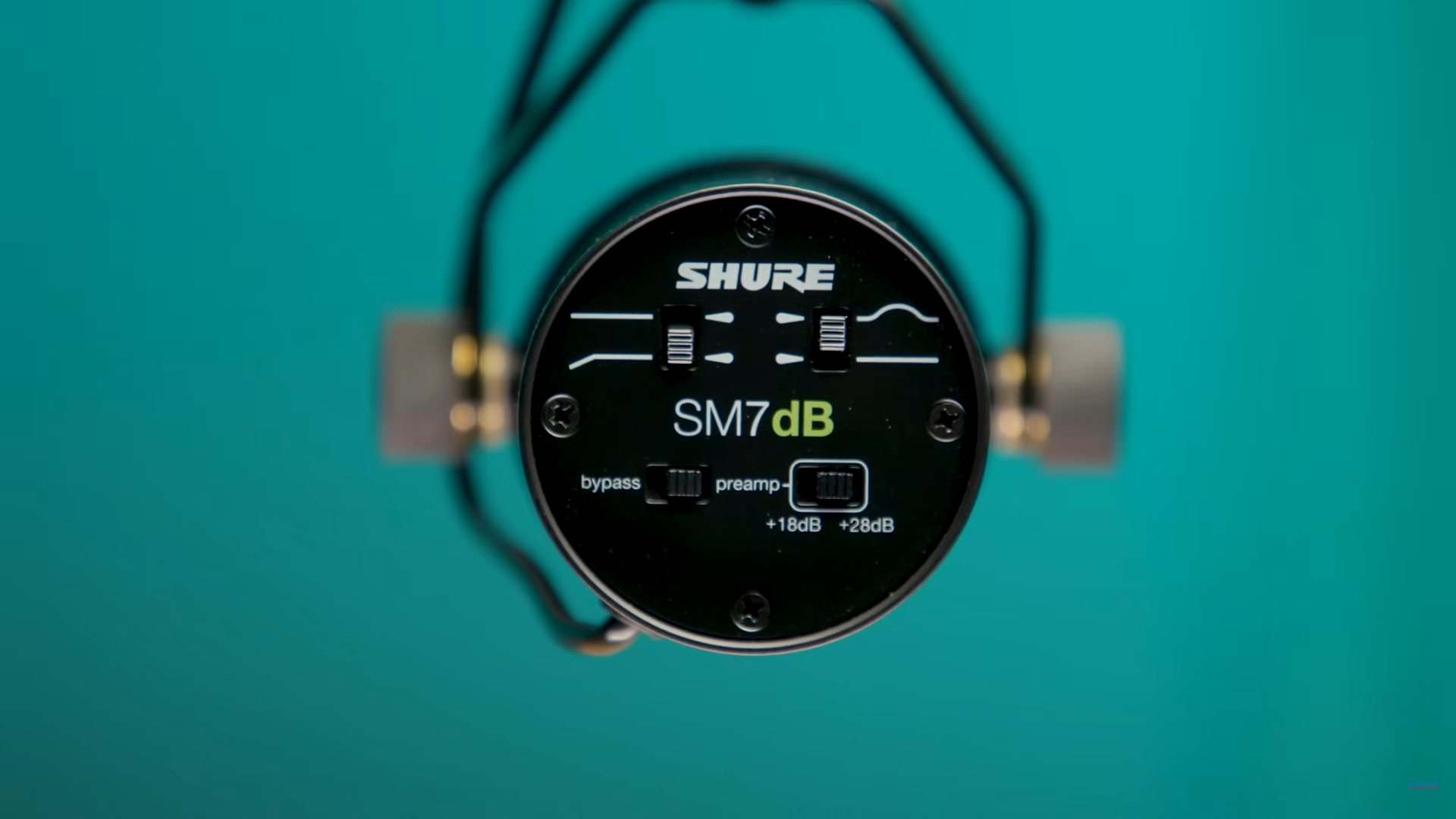
Back Switches
The SM7dB features more tactile EQ switches on the back. Now, you can just use your fingers to move them.
With the original SM7B, you’d have to use a small tool or pen to flip the switches.
While this feature is a nice quality-of-life enhancement, most folks probably won’t ever use these switches.
Finish & Logo
The original SM7B has an all-black finish — it’s boring, yet beautiful.
On the other hand, the SM7dB has a more glossy-looking finish. The Sure logo is also brandished on the side for all to see (a.k.a. free advertising). Depending on who you are, it may or may not bother you.
It’s not as prominent as the all-white logo on the Shure MV7, but still noticeable.
Which Mic Is Right For You?
I’ve said it multiple times now: These are essentially the same microphone. In a blind test, you probably couldn’t tell them apart.
So if you’re buying your first Shure broadcast microphone, you can’t go wrong with either one.
But to address the elephant in the room: there’s a $100 difference between the SM7B and SM7dB. So the question is: Do you want to pay for the extra signal boost, or go with the tried and true original?
The SM7dB offers more flexibility for recording in different situations. And depending on the setup, it requires less gear to run.
But if you already have an SM7B and/or a good audio interface with high preamp gain, then don’t bother with the new version.
The industry-standard broadcast microphone. This celebrated mic is the go-to for countless singers, voice-over artists, podcasters, YouTubers, and everyone in between.
Shure's new and improved broadcast microphone. It has the same smooth sound as the classic SM7B, but has the added benefit of a built-in preamp. Plug it directly into your audio interface without using any external signal boosters!
Need Ideas for Other Microphones? Try These SM7B Alternatives
The SM7B isn’t the only broadcast microphone in town. Try looking into these other great SM7B alternatives.
